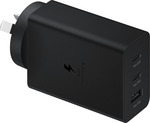Seems like a good price.
Color
Black
General Feature
Features
(USB-C1) Super Fast Charging 2.0 max. 45 W, PD 3.0 PDO max. 65 W, PPS max. 45 W / (USB-C2) Super Fast Charging max. 25 W, PD 3.0 PDO,PPS max. 25 W / (USB-A) AFC,QC max. 15 W / (C1+C2) 40 W + 25 W / (C1+A) 50 W + 15 W / (C2+A) 25 W + 15 W / (all) 35 W + 25 W + 15 W
Interface
USB-C x2, USB-A
Packaging Contents
Power Adapter, Quick Start Guide
Physical specification
Dimension (WxHxD)
52 x 30 x 96.9 mm
Weight
157 g
Electrical
Input Voltage
100-240 V
Output Voltage (Max, Normal Charge)
5 V
Output Voltage (Max, Fast Charge)
(USB-C1, PDO) 9 V, 15 V, 20 V / (USB-C1, PPS) 5.0-20.0 V / (USB-C2, PDO) 9 V / (USB-C2, PPS) 5.0-11.0 V / (USB-A) 9 V
Output Current (Max, Normal Charge)
3 A
Output Current (Max, Fast Charge)
(USB-C1, PDO) 3 A(9 V), 3 A(15 V), 3.25 A(20 V) / (USB-C1, PPS) 3.5 A(5.0-11.0 V), 2.8 A(5.0-16.0 V), 2.25 A(5.0-20.0 V) / (USB-C2, PDO) 2.77 A(9 V) / (USB-C2, PPS) 3.0 A(5.0-5.9 V), 2.25 A(5.0-11.0 V) / (USB-A) 1.67 A(9 V)




Good price for a big-name charger. It's pretty big compared to a GaN charger though.